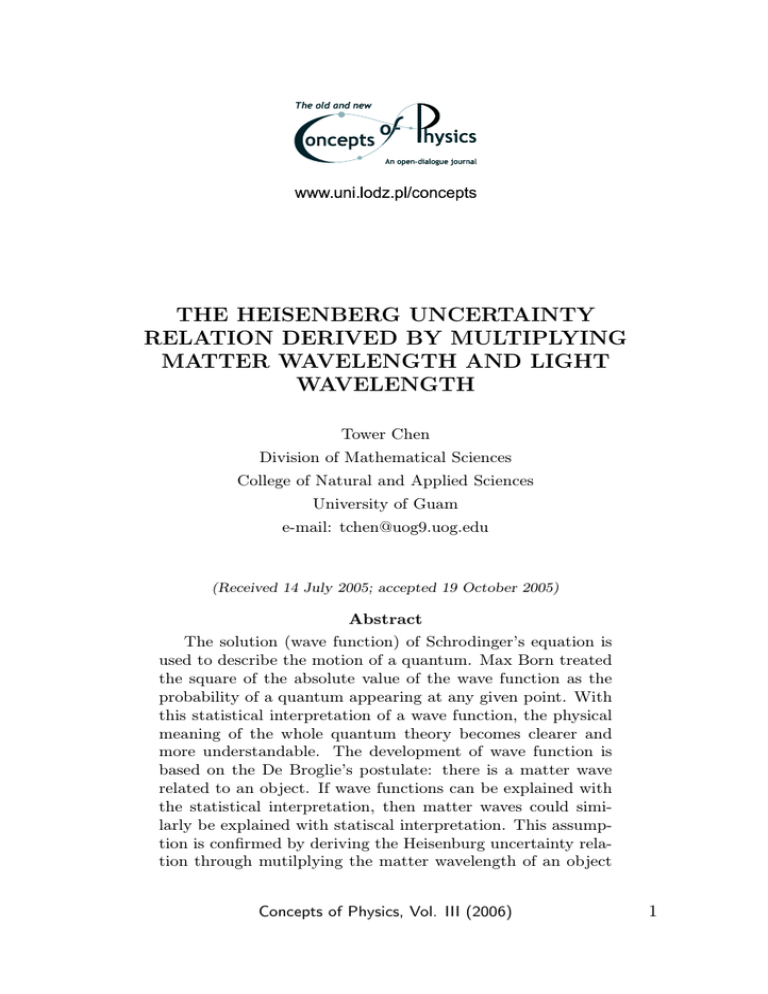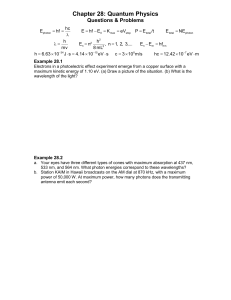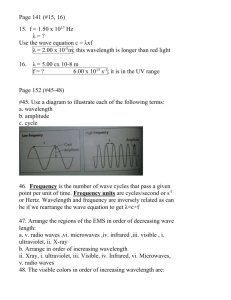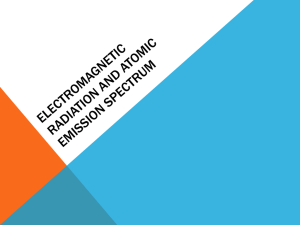THE HEISENBERG UNCERTAINTY RELATION DERIVED BY MULTIPLYING MATTER WAVELENGTH AND LIGHT WAVELENGTH
advertisement

THE HEISENBERG UNCERTAINTY RELATION DERIVED BY MULTIPLYING MATTER WAVELENGTH AND LIGHT WAVELENGTH Tower Chen Division of Mathematical Sciences College of Natural and Applied Sciences University of Guam e-mail: tchen@uog9.uog.edu (Received 14 July 2005; accepted 19 October 2005) Abstract The solution (wave function) of Schrodinger’s equation is used to describe the motion of a quantum. Max Born treated the square of the absolute value of the wave function as the probability of a quantum appearing at any given point. With this statistical interpretation of a wave function, the physical meaning of the whole quantum theory becomes clearer and more understandable. The development of wave function is based on the De Broglie’s postulate: there is a matter wave related to an object. If wave functions can be explained with the statistical interpretation, then matter waves could similarly be explained with statiscal interpretation. This assumption is confirmed by deriving the Heisenburg uncertainty relation through mutilplying the matter wavelength of an object Concepts of Physics, Vol. III (2006) 1 with the light wavelength of measuring medium. This new approach may offer another view to look at the reality of M. Born’s statistical interpretation of the wave function solution of Schrodinger’s equation. 2 Concepts of Physics, Vol. III (2006) The Heisenberg uncertainty relation... 1 Introduction Einstein proposed that light exhibited the properties of particles. Each photon carries the energy (E) of hν and the momentum (p) of h/λ. Conversely, de Broglie suggested that objects exhibited wavelike properties, guided by the analog dual properties of light. The de Broglie’s two postulates: (1) the wavelength, λ, of quantum matter wave is equal to h/p ( λ = h/p) and (2) the frequency, ν, is equal to E/h (ν = E/h). Because the phase velocity, vp , of matter wave is defined as λν (vp = λν) and from the formula E = p2 /2m, the phase velocity is derived equal to (1/2)v ( vp = (1/2)v) where v is the velocity of a quantum. The phase velocity is only half the velocity of a quantum, matter wave attached to a quantum cannot be a single wave and must be modified as wave packet. The group velocity, vg , of wave packet is defined as d$/dk, it can be derived as equal to v (vg = d$/dk = v). Although the group velocity is the same as the velocity of a quantum, there are some paradox related to wave packet: (1) the disperse of wave packet after a period of time, (2) self interference after passing an equipment, (3) probability wave of matter wave. In order to avoid this problem, the one of two properties of matter wave can be changed to vp = λν = v, and the other one λ = h/p is kept same. The frequency, ν, of the matter wave can be derived as 2Ek /h (ν = 2Ek /h) which is different from de Broglie’s one postulate (ν = Ek /h). Because ν is not able to be measured for a quantum, we can not prove which one is right from Ek = hν, or Ek = (1/2)hν. In practice, Ek can be calculated from the momentum through the formula Ek = p2 /2m not from the frequency through the formula Ek = hν. In the wave function, ν goes to phase angle, ν = Ek /h or ν = 2Ek /h would not affect the result of calculating physical measurements. The physical meaning of the wavelength of matter wave will be studied by proposing the phase velocity of matter wave equal to the velocity of a quantum. Any macro object is made from micro quanta. Where is the line separating macro from micro? The motion of a macro object or a micro quantum is observed the only difference between a macro object and a micro quantum is that one is visible and the other is invisible while interacting with measurement equipment. The position and velocity of a macro object can be measured by beams of photon, Concepts of Physics, Vol. III (2006) 3 Tower Chen because the second beam of photon can be seen to hits the same spot as the first beam with the naked eye. However, the position and velocity of a micro quantum cannot be measured by beams of photon because the second beam of photon cannot be proven to contact the same spot as the first beam since the point of contact is invisible to the naked eye. There are two uncertain measurements related to this measuring: the probability of hitting different spots which is inversely proportional to mass and velocity, and the probability of hitting either the front or the rear of the wave of the photon wave which is proportional to the wave length. The matter wavelength can be explained as the probability of uncertainty in measuring a quantum with the unit of length. The second beam of photon may hit a different spot from the first one because of the rotation of the particle. Whether it is a macro or a micro particle, when it moves forward and is hit by other particles, there would be some sort of rotation (not spin) inflicted on the particle. For example: if there are many tennis balls bouncing up and down in a long channel and if a football is thrown through the channel, the football will be seen moving forward with some sort of rotation after passing the channel. The faster the football is traveling the less rotation is inflicted on the football. Similarly, the heavier the mass of the football is, the less rotation is inflicted on the football. This shows that the speed of the rotation is inversely proportional to the momentum of the football. To verify the assumptions made previously, the Heisenberg uncertainty relationship can be derived by multiplying these two independent probabilities (matter wavelength of an object and light wavelength of measuring medium). 2 Measuring a macro object In the first case, we will examine the measurement of the position and velocity of a macro object (visible to the eye) by means of photons. When the position of an object is measured by photons, the place on the object where a photon makes contact is visible, because the object is a visible particle. During the experiment, the position where the second beam of photon hits can be determined to be the same spot as the contact point of the first beam of the photon, because the object is visible. If the second beam of photon hits 4 Concepts of Physics, Vol. III (2006) The Heisenberg uncertainty relation... a different spot from the first, the experiment should be repeated. This accounts for man’s ability to measure the position and velocity of a macro object accurately, i.e. the ability to see the object being measured. 3 Measuring a micro quantum In the second case, we will examine the measurement of the position and the velocity of a micro quantum (invisible to the eye) by photons. When the position of a quantum is measured by photons, the spot on the quantum where a beam of photon hits cannot be determined because the quantum is not visible. Therefore, it is impossible to distinguish the contact point of the second beam of photon to be the same as the contact point of the first beam of photon. There is rotation on the part of the quantum when it travels forward. However, the quantum is invisible and its rotation cannot be detected. This fact attributes to the uncertainty in measurement of the position and velocity of a micro quantum. 4 Theory When a particle moves forward leaving from the system, there is rotation on the part of the particle. The larger the mass of a particle, the slower the rotation will be. Similarly, the faster the movement of a particle, the slower the rotation will be. Therefore, the probability of the first and second beams of photons hitting the same spot of the object is proportional to the mass and the velocity of the particle. In other words, the probability of an accurate measurement is proportional to the momentum of the particle. On the contrary, the probability of an uncertainty measurement is inversely proportional to the momentum of the particle. The probability of uncertain measurement is proportional to (1/mv). If Planck’s constant, h, is chosen as the constant of proportionalilty, then the probability of uncertain measurement is equal to (h/mv). Because the unit of h/mv is the unit of length, the probability of uncertain measurement linked to a quantum itself is defined as the wavelength of quantum, λq . This approach explains the real meaning of a wavelength of a quantum matter wave postulated by de Broglie. The above formula can be rewritten as Concepts of Physics, Vol. III (2006) 5 Tower Chen λq = h/mv (1) The position and velocity of a quantum is measured by photons. A photon can also be treated as a wave. When a photon wave hits the quantum, whether the front or the rear of a photon wave hits the quantum cannot be detected. There is the probability of this additional uncertain measurement, which is equal to the wavelength of a photon wave, λl . The velocity of a photon wave, which is equal the wavelength divided by the period Tl , is a constant: λl = cTl (2) These two uncertain measurements are independent; the total probability of uncertain measurements is equal to the product of these two wavelengths: λq λl = (h/mv)(cTl ). (3) After rearrange the equation, we can get m(λq /Tl )λl = h(c/v). (4) By setting ∆v = λq /Tl and ∆x = λl , the equation is change to (m∆v)(∆x) = h(c/v) (5) Because of ∆p = m∆v and (c/v) ≥ 1, the Heisenberg uncertainty relationship is derived as follows ∆p∆x ≥ h (6) This proof of the Heisenberg uncertainty relation confirms our assumptions, and may helps us understanding reality of Born’s statistical interpretation of wave functions.The other form of Heisenberg uncertainty relationship can be derived similarly. From Eq.(3), it follows λq λl = (h/p)(cTl ). (7) After rearrange the equation, we can get p(λq /Tl )(λl /c) = h. 6 Concepts of Physics, Vol. III (2006) (8) The Heisenberg uncertainty relation... By setting ∆v = λq /Tl and Tl = λl /c, the equation is changed to p∆vTl = h. (9) Multiplying m on the numerator and denominator of the left side of the above equation, we can get (pm∆v/m)Tl = h. (10) Because of ∆p = m∆v, the equation is changed to (p∆p/m)Tl = h. (11) From E = p2 /(2m), we can get ∆E = p∆p/m. If we let ∆t = Tl , the other form of the Heisenberg uncertainty relation is derived as follows ∆E∆t = h. (12) 5 Conclusions When the motion of a micro quantum is described by emitting photons without being able to see the point of contact, the probabilities of two uncertain measurements (due to the rotation of a quantum and the wavelength a photon wave) are unavoidable. The Heisenberg uncertainty relation is proved by simply multiplying two wavelengths: the wavelength of a quantum matter wave and the wavelength of a photon wave. This proof leads to the conclusion that the wavelength of a quantum matter wave, which is equal to h/p postulated by de Broglie, is actually a probability wavelength, not a conventional wavelength. If a quantum matter wave is treated as a conventional wave, the width of a wave packet (a superposition of waves with different wavelengths) is utilized to explain Heisenberg uncertainty relation. Because the wave packet disperses as the particle travels forward, the difficulty of a classical wave packet representing the particle still exist, which is contradictory to our experiment. The wavelength of a matter wave is shown to be a probability wavelength always associated to the particle due to the rotation (not spin) of the particle, the probability wave of the particle does not disperse as the particle Concepts of Physics, Vol. III (2006) 7 Tower Chen moves forward. Heisenberg uncertainty relation can be derived by multiplying a probability wavelength due to the rotation of a particle and the wavelength of a photon wave due to measuring medium. This new approach may offer another view to look at the reality of M. Born’s statistical interpretation about the wave function of the solution of Schrodinger’s equation. 6 Reference Bohm, D., 1951, ”Quantum Theory”, Dover. Dirac, P. A. M., 1958, ”The Principles of Quatum Mechanics”, 4th ed., Oxford University Press. Healey, R. A., 1989, ”The Philosophy of Quantum Mechanics”, Cambridge University Press. Sakurai, J. J., 1985, ”Mordern Quantum Mechanics”, Benjamin. Wheeler, A., and Zurek, W. H., ed., 1983, ”Quantum Theory and Measurement”, Princeton University Press. Herbert, N., 1985, ”Quantum Reality”, Anchor Press. Feyman, R. P. and Hibbs, A. R., 1965, ”Quantum Mechanics and Press Integral”, McGraw-Hill. Auyang, S. Y., 1995, ”How Is Quantum Field Theory Possible?”, Oxford University Press. Brandt S. and Dahmen H. D., 1995, ” The Picture Book of Quantum Mechanics”, Springer-Verlag. Cao, T. Y. 1997, ”Conceptual Development of 20th Century Field Theories”, Cambridge University Press 1997. 8 Concepts of Physics, Vol. III (2006)







